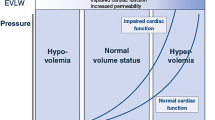Abstract
Objective. The objective of this study was to evaluate the effect of positive end-expiratory pressure (PEEP) on capnography.Design. The study design was experimental and open, and it was performed in the Anesthesiology Experimental Research Laboratory.Methods. Six dogs (9.8±0.8 kg) were anesthetized and intubated. The animals' lungs were ventilated with a tidal volume of 137±34 ml and a respiratory frequency of 34±10 breaths/min to produce a Paco 2 of 35 to 45 mm Hg. Application of 20 cm H2O of PEEP was initiated for 1 minute, then repeated twice after 10-minute stabilization periods. Arterial pH and gas tensions were measured, and capnogram, airway gas flow, and airway pressure were recorded continuously. Airway gas flow was electronically integrated to calculate tidal volume.Results. Mean values before application of PEEP were as follows: pHa, 7.37±0.04 mm Hg; Paco 2, 37.1±3.2 mm Hg; PaO2, 93.4±1.6 mm Hg; andPetco 2, 32.0±3.5 mm Hg. Compliance of the ventilator circuit was 3.3 ml/cm H2O. Mean deflation lung-thorax compliance was 41.5±10.3 ml/cm H2O. After application of PEEP, no capnogram was reported for 1 to 6 breaths, an average of 2.7±1.8 breaths.Conclusions. These results demonstrated that absence of gas flow immediately after the application of PEEP may transiently abolish a capnogram when the lung volume increases.
Similar content being viewed by others
References
Cooper JB. Unidirectional PEEP valves can cause safety hazards. Anesthesia Patient Safety Foundation Newsletter 1990;5:28–29
Arellano R, Ross D, Lee K. Inappropriate attachment of PEEP valve causing total obstruction of ventilation bag. Anesth Analg 1987;66:1050–1051
Dunn SM, Mushlin PS, Lind LJ, Raemer D. Tracheal intubation is not invariably confirmed by capnography. Anesthesiology 1990;73:1285–1287
Markovitz BP, Silverberg M, Godinez RI. Unusual cause of an absent capnogram. Anesthesiology 1989;71:992–993
Chapin JC, Downs JB, Douglas ME, Murphy EJ, Ruiz BC. Lung expansion, airway pressure transmission, and positive end-expiratory pressure. Arch Surg 1979;114:1193–1197
Author information
Authors and Affiliations
Rights and permissions
About this article
Cite this article
Bowie, J.R., Smith, R.A. & Downs, J.B. Absence of a capnogram after positive end-expiratory pressure. J Clin Monitor Comput 9, 78–80 (1993). https://doi.org/10.1007/BF01616918
Received:
Revised:
Accepted:
Issue Date:
DOI: https://doi.org/10.1007/BF01616918




